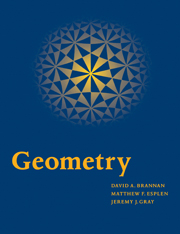Book contents
- Frontmatter
- Contents
- preface
- Introduction: Geometry and Geometries
- 1 Conics
- 2 Affine Geometry
- 3 Projective Geometry: Lines
- 4 Projective Geometry: conics
- 5 Inversive Geometry
- 6 Non-Euclidean Geometry
- 7 Spherical Geometry
- 8 The Kleinian View of Geometry
- Appendix 1 A Primer of Group Theory
- Appendix 2 A Primer of Vectors and Vector Spaces
- Appendix 3 Solutions to the Problems
- Index
6 - Non-Euclidean Geometry
Published online by Cambridge University Press: 05 June 2012
- Frontmatter
- Contents
- preface
- Introduction: Geometry and Geometries
- 1 Conics
- 2 Affine Geometry
- 3 Projective Geometry: Lines
- 4 Projective Geometry: conics
- 5 Inversive Geometry
- 6 Non-Euclidean Geometry
- 7 Spherical Geometry
- 8 The Kleinian View of Geometry
- Appendix 1 A Primer of Group Theory
- Appendix 2 A Primer of Vectors and Vector Spaces
- Appendix 3 Solutions to the Problems
- Index
Summary
Non-Euclidean geometry was one of the most momentous mathematical discoveries of the 19th century. It had several revolutionary implications, because it provided a physically plausible description of space that differed markedly from Euclid's. It became possible to imagine that the universe is non-Euclidean, and in the 19th century some mathematicians and astronomers, such as Gauss and his friend Bessel, entertained the idea quite seriously.
The theorems in non-Euclidean geometry often differ markedly from their Euclidean equivalents. For example, in Euclidean geometry the angles of any triangle sum to π; in non-Euclidean geometry the angle sum of any triangle is strictly less than π. It follows that some empirical observations (such as measuring the angle sum of some very large triangles) are needed to determine if space is to be described by Euclidean or non-Euclidean geometry. This spelled an end to the hope, alive since Greek times, that purely logical reasoning could give knowledge about physical space. And of course it might be worse: once one non-Euclidean geometry has been found, why might there not be others, all different and all equally plausible?
What gives non-Euclidean geometry its close resemblance to Euclidean geometry, and explains its name, can best be understood by looking briefly at Euclid's Elements. This book, which underlay most geometrical teaching in the West for over 2000 years, gave definitions of the basic terms in the subject and rules (called postulates) for their use.
- Type
- Chapter
- Information
- Geometry , pp. 261 - 326Publisher: Cambridge University PressPrint publication year: 1999



